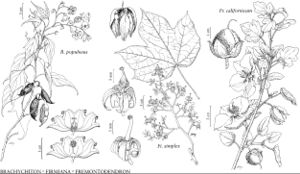Firmiana
Saggi Sci. Lett. Accad. Padova 1: 115. 1786.
| Taxon | Illustrator ⠉ | |
|---|---|---|
 | Brachychiton populneus Firmiana simplex Fremontodendron californicum | Linny Heagy Linny Heagy Linny Heagy |
Trees [shrubs], deciduous. Leaves: stipules caducous; blade usually lobed, base often cordate, palmately 5–7-veined. Flowers unisexual or rarely bisexual (plants monoecious or polygamous); sepals 5, ± connate into tube. Staminate flowers: stamens [10–] 15; anthers shortly stipitate or sessile, 2-celled, dehiscing longitudinally; pistillode present. Pistillate flowers: ovary 5-locular, pyriform [ovoid or globose], base ringed with [10–] 15 indehiscent anthers; ovules 2–6 per locule; styles 5, basally connate; stigmas 5. Follicles stipitate, chartaceous, foliaceous, dehiscent long before maturity and exposing seeds adhering to margins. Seeds globose, smooth, wrinkled when dry, glabrous; endosperm abundant; embryo straight. x = 10.
Distribution
Introduced; Asia, Pacific Islands
Discussion
A. J. G. H. Kostermans (1954, 1956, 1957) used follicle dehiscence to separate Firmiana from the closely related Hildegardia; follicles are dehiscent in the former and indehiscent in the latter. However, molecular evidence suggests that fruit dehiscence is not a defining generic character and it now appears that the species of Firmiana and Hildegardia with deeply lobed calyces form a clade (P. Wilkie et al. 2006). This would tend to support the practice in some Asian floras of recognizing the species of Firmiana with infundibuliform calyces as Erythropsis Lindley ex Schott & Endlicher. Although generic boundaries are poorly defined, and with better molecular sampling probably will change, Firmiana is the oldest generic name available for these three related taxa and likely will continue to be applied to the species found in our flora.
Species ca. 12 (1 in the flora).